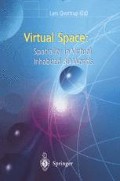Abstract
Information technology has changed the role space and time plays in our lives. The Internet connects people that are geographically far apart, Timbuktu is only a mouse click away, virtual reality replaces the real space with a life-like simulacrum, and augmented reality smears an informational coating over real space.
Access this chapter
Tax calculation will be finalised at checkout
Purchases are for personal use only
Preview
Unable to display preview. Download preview PDF.
References
Holbxk-Hansen, E., Håndlykken, P. and Nygaard, K. (1975) System Description and the Delta Language. Norwegian Computing Center, Publ. No. 523.
Jacobsen, E. E., Kristensen, B. B. and Nowack, P. (1998) Models, domains, and abstractions in software development. Proceedings of International Conference on Technology of Object-Oriented Languages and Systems (TOOLS Asia’98), Bejing, China.
Jacobson, I., Booch, G and Rumbaugh, J. (1999) The Unified Development Process. Addison-Wesley.
Kristensen, B. B., Madsen O. L., Moller Pedersen, B. and Nygaard, K. (1983) Abstraction mechanisms in the BETA programming language. In Proceedings of the 10th ACM Symposium. Principles of Programming Languages.
Lind, M. (2000) Actions, Functions and Failures in Dynamic Environments. Center for Human Machine Interaction. CHMI-8–00http://www.cs.auc
Luhmann, N. (1984) Soziale Systeme. Frankfurt am Main: Suhrkamp.
Mathiassen, L., Munk-Madsen, A, Nielsen, P. A. and Stage, J. (2001) Object-Oriented Analysis and Design. Marko.
May, D. C., Kristensen, B. B. and Nowack, P. (2001) Tangible Objects - Modeling in Style. Proceedings of Second International Conference on Generative Systems in the Electronic Arts (Second Iteration - Emergence), Melbourne, Australia, 2001.
White, J. (1996) Mobile agents white paper.http://www.genmagic.com/agents/Whitepaper/whitepaper. Html
Editor information
Editors and Affiliations
Rights and permissions
Copyright information
© 2002 Springer-Verlag London
About this chapter
Cite this chapter
Andersen, P.B., Nowack, P. (2002). Tangible Objects: Connecting Informational and Physical Space. In: Qvortrup, L., Jensen, J.F., Kjems, E., Lehmann, N., Madsen, C. (eds) Virtual Space. Springer, London. https://doi.org/10.1007/978-1-4471-0225-0_9
Download citation
DOI: https://doi.org/10.1007/978-1-4471-0225-0_9
Publisher Name: Springer, London
Print ISBN: 978-1-4471-1100-9
Online ISBN: 978-1-4471-0225-0
eBook Packages: Springer Book Archive

